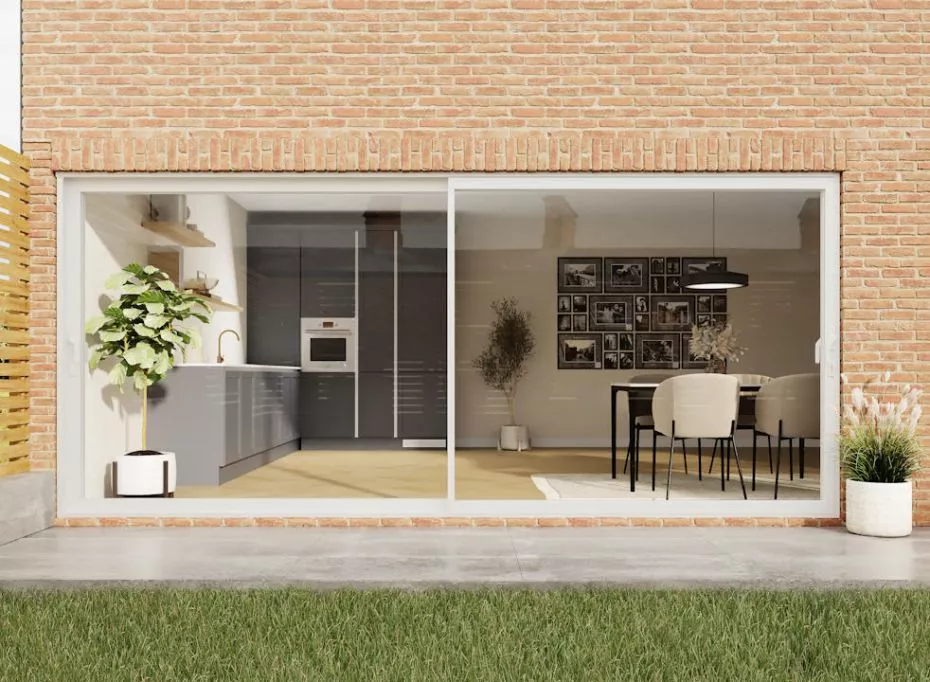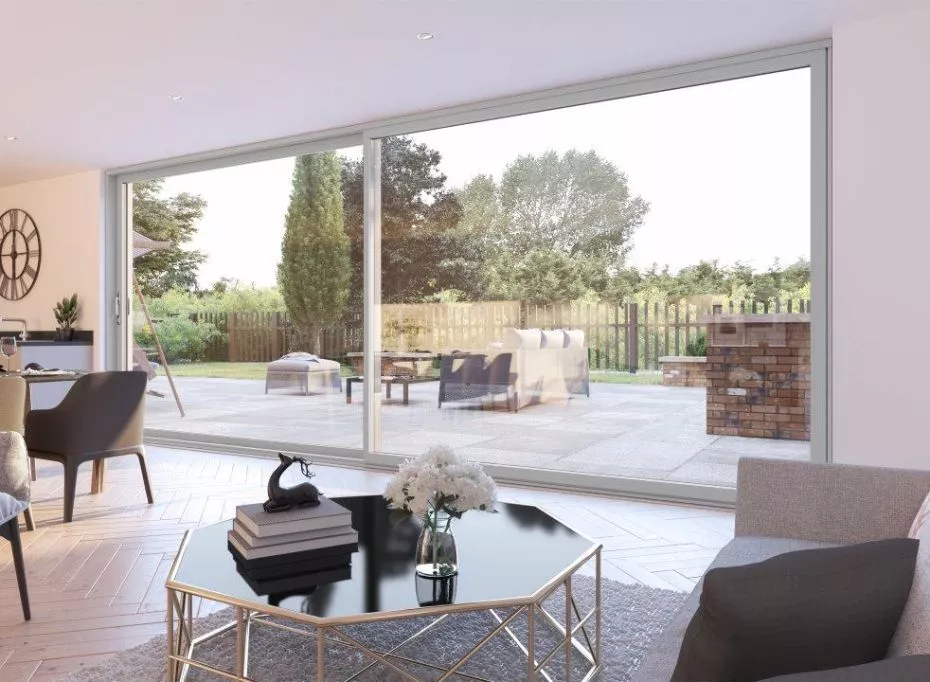A complete guide to understanding sliding door thermal efficiency
Having a thermally efficient home provides many benefits, such as increased comfort and lower energy costs. The internal and external doors you choose can be a great influence on how thermally efficient your home is, depending on the materials used, the thickness of the doors and the glazing (for doors with glass panels). Internal and external sliding doors can be a great addition to your home, providing a modern touch as well as improving thermal efficiency.
Explore our guide to discover more about improving thermal efficiency in your home with sliding doors, as well as their U-values and how these compare to bifold doors. We also discuss aluminium sliding door thermal breaks, the benefits of double-glazed sliding doors, and how double glazing compares to triple glazing.
In this guide:
Find out more about how your doors could lower your energy bills
Discover more about the importance of low U-values
Compare the thermal efficiency of sliding doors to bifold doors
Here’s some more information on sliding door thermal breaks
Find out how double-glazed sliding doors can benefit your home
Compare double-glazed to triple-glazed sliding doors
How to Improve Thermal Efficiency with Sliding Doors
When choosing sliding doors, the material has a major impact on energy efficiency and long-term performance. The most common options include:
- Aluminium: Favoured for its strength and contemporary appearance. Though not naturally insulating, modern aluminium doors include thermal breaks to improve energy performance.
- Timber: A natural insulator with traditional charm. Engineered timber enhances both insulation and durability.
- uPVC: Lightweight, low-maintenance, and cost-effective, uPVC offers good insulation but tends to be less robust than other materials.
- Composite: Combining materials like timber and aluminium, composite frames deliver the insulation of wood with the resilience of metal.
Your choice should reflect your home’s climate, style preferences, and how much maintenance you're willing to undertake. Look for strong frame materials to support heavier glazing like triple glazing. Our Supreme aluminium sliding doors, for example, offer excellent thermal efficiency with U-Values as low as 1.6 W/m²K.
Seals and weatherstripping are essential for preventing draughts and retaining heat. Ensure these components are properly fitted and replace them when worn.
Routine maintenance such as cleaning tracks, checking seals, lubricating parts, and inspecting glazing helps preserve performance and prolongs the lifespan of your doors.
Our aluminium sliding doors come equipped with thermal breaks and Low-E glass, combining stylish design with high energy efficiency from as little as £2,349
Find out more in our previous guide here.

Sliding Door U-Values
U-Values measure how well a material retains heat, with lower values indicating better thermal insulation. Expressed in W/m²K, U-Values are crucial when selecting sliding doors, as their large, glazed areas can significantly impact a home's energy efficiency.
Low U-Value sliding doors help reduce heat loss in winter, limit heat gain in summer, and cut down on energy bills by improving overall insulation. They also support a more comfortable indoor environment and contribute to a lower carbon footprint.
Several factors influence U-Values:
- Material: Aluminium frames are strong and durable, especially when fitted with thermal breaks to improve insulation. Timber offers excellent natural insulation but requires more upkeep. uPVC is budget-friendly and low-maintenance but typically less robust and offers thicker sightlines.
- Glazing: Double or triple glazing, gas-filled panes (e.g. argon), and low-emissivity (Low-E) coatings can all improve a door’s thermal performance.
- Installation: Proper fitting is key. Poor installation can lead to air leaks, reducing efficiency. Regular maintenance helps retain performance over time.
Our Supreme aluminium sliding doors feature thermal breaks and Low-E glass, achieving U-Values as low as 1.6 W/m²K. For even better performance, the Status range reaches 1.4 W/m²K.
Low U-Value doors enhance comfort, reduce noise, improve sustainability, and may increase your home’s value.
Find out more about sliding door U-values here.
How Do Sliding Door U-Values Compare to Bifold Door U-Values?
Sliding and bifold doors can both offer excellent thermal efficiency, with U-values as low as 1.4 W/m²K, depending on materials and glazing. There is no clear winner in terms of energy performance; what matters most is the specific construction and features of the doors. Our aluminium sliding and bifold doors are all built to deliver strong insulation and improved energy savings.
Sliding doors with low U-values help reduce heat loss, improve insulation, and lower energy bills. They offer greater comfort year-round by maintaining a stable indoor temperature, ensuring they are cooler in summer and warmer in winter. In addition to reducing your home’s carbon footprint, these doors can also increase property value, appealing to eco-conscious buyers.
Your choice largely depends on space and style preferences. Bifold doors open fully by folding to the side, ideal for summer living. Sliding doors provide sleek, modern sightlines and uninterrupted views, making them great for year-round use in tighter spaces.
Read our previous guide on sliding door U-values and bifold U-values here.
What are Aluminium Sliding Door Thermal Breaks?
Thermal breaks are essential components in aluminium sliding doors that significantly improve their energy efficiency. As aluminium is a highly conductive material, it can easily transfer heat or cold between indoors and outdoors. A thermal break addresses this by inserting a low-conductivity material, such as polyamide, between the internal and external parts of the frame. This barrier slows heat transfer, helping to maintain a stable indoor temperature.
Without a thermal break, aluminium doors can allow unwanted heat to escape in winter and enter in summer, reducing comfort and increasing energy bills. With a thermal break, however, the insulation improves, keeping homes warmer in winter and cooler in summer.
The benefits of aluminium sliding doors with thermal breaks include:
- Enhanced energy efficiency: Lower heating and cooling costs and reduced carbon footprint.
- Improved comfort: More consistent indoor temperatures all year round.
- Condensation prevention: Warmer interior surfaces reduce the risk of damp and mould.
- Long-lasting durability: Aluminium remains strong and resistant to rust or warping.
- Aesthetic flexibility: Slim frames allow for larger glass panels and modern designs.
- Low maintenance: Less upkeep than timber and better protection from temperature-related stress.
Find out more in our previous guide here.

Shop the Status aluminium sliding door range.
Benefits of Double-Glazed Sliding Doors
Double glazed sliding doors feature two panes of glass separated by a gap filled with air or inert gas (e.g., argon), providing effective insulation against heat loss. This design makes them a popular choice for energy-conscious homeowners looking to enhance comfort and reduce heating bills.
These doors glide smoothly along a track, saving space and offering uninterrupted views. Their modern appearance suits a range of home styles, and materials such as aluminium allow for slim frames and large glass panels that maximise natural light.
Key Benefits:
- Energy Efficiency: The double glazing helps maintain indoor temperatures year-round, reducing reliance on heating and cooling systems.
- Comfort & Style: They create a light-filled, pleasant living space and can be customised with different finishes and glazing options.
- Space Saving: As they slide rather than swing, they’re ideal for compact areas.
- Indoor-Outdoor Flow: Large panes offer clear views and easy access to patios or gardens.
- Durability: Aluminium frames and toughened glass offer long-lasting, low-maintenance performance.
Read our previous guide discussing the benefits of double-glazed sliding doors here.
Double Glazing vs. Triple Glazing Sliding Doors
Double glazing is a widely used solution in UK homes to improve energy efficiency. It consists of two panes of glass separated by a sealed gap filled with air or inert gas (typically argon). This structure forms an insulating barrier that reduces heat loss in winter and heat gain in summer, helping maintain a stable indoor temperature and cutting energy bills.
Benefits of double glazing include strong thermal performance, noise reduction, and cost-effectiveness, especially when compared to triple glazing. Our double-glazed sliding doors, achieve U-values as low as 1.4–1.6 W/m²K, meeting UK energy standards with ease.
Triple glazing, with three panes of glass and two insulating layers, offers even greater thermal efficiency and soundproofing, ideal for colder climates or noisy areas. However, it is heavier, more expensive, and not always necessary for milder regions.
In most cases, double glazing provides excellent performance and better value for money. It's also lighter and more compatible with existing frames. Our aluminium sliding doors with thermal breaks and Low-E glass further enhance insulation while offering durability and a sleek, modern look. For most UK homes, double glazing remains a smart, efficient, and practical choice.
Choose between double and triple-glazed sliding doors in our previous guide here.

About John Collins
John has built Vufold into a unique online door and window company and has spent 20 years bringing innovative products and designs to fruition, recognising niches in the market and placing them in the likes of Wickes and Travis Perkins, he started Vufold in order to sell them directly. John founded Vufold and has amassed a wealth of experience in product design and development, and in particular timber-based products
Read more about John Collins

